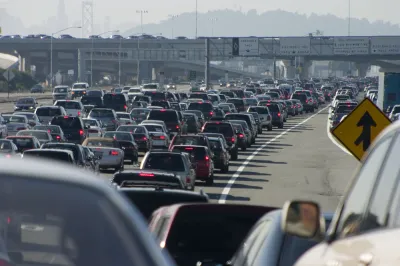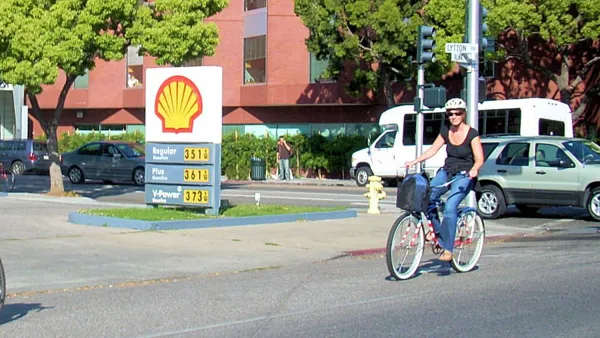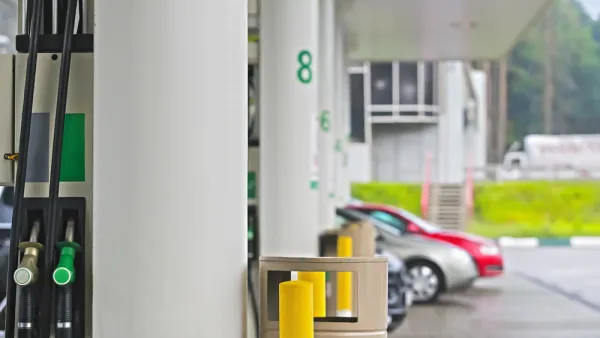The transportation research group, TRIP, tallied costs from additional crashes, higher operating costs, and congestion that result from insufficient investment in California's roads and bridges. A new effort was launched to increase state funding.

Insufficient investment in California's road system is by no means a new revelation. Gov. Jerry Brown announced his priority to tackle "the enormous $59 billion problem of deferred highway and bridge maintenance" in his 2015 joint inauguration and state of the state address.
A year later, the deficit had swelled to $77 billion. And it didn't help that California's gas tax decreased by 2.2 cents per gallon on July 1, the third consecutive year the Board of Equalization voted to reduce the tax. In the face of falling gas tax revenues, the California Transportation Commission announced on Jan. 22 that it would slash spending by $754 million on current projects over five years.
The 24-page report [PDF], released Aug. 17 on the state of California's road and bridges by TRIP (formerly The Road Information Program), a private, nonprofit national transportation research group based in Washington, D.C., is helpful in that it quantifies some of the costs that motorists pay when infrastructure investment falls way behind. In the Bay Area and Southern California, costs to motorists averaged over $2,800 annually.
"Roads and bridges that are deficient, congested or lack desirable safety features cost California motorists a total of $53.6 billion statewide annually," reports Rocky Moretti, Director of Policy and Research for TRIP.
The TRIP report finds that 37 percent of major locally and state-maintained roads are in poor condition. One quarter of California’s bridges are structurally deficient or functionally obsolete.
The group breaks out costs into three areas:
- Higher vehicle operating costs,
- Traffic crashes
- Congestion-related delays.
The report details costs for five regions, which have their own press releases:
- Los Angeles-Long Beach-Santa Ana urban area
- Sacramento area
- San Diego area
- San Francisco-Oakland urban area
- San Jose urban area
New legislation will tackle infrastructure deficit
To address these costs, the chairs of the Assembly and Senate Transportation Committees announced plans on Aug. 17 to increase transportation funding by hiking fuel taxes to raise $7.4 billion.
"The plan, highlighted by an increase of 17 cents per gallon in the gas tax, comes from Assemblyman Jim Frazier (D-Oakley, Contra Costa County) and Sen. Jim Beall (D-San Jose) in an attempt to unify the disparate proposals the pair had previously introduced in their respective houses," reported Liam Dillon for the Los Angeles Times on Aug. 17. In addition, the proposal, which has yet to be introduced as a bill, includes:
- A diesel tax increase of 30 cents per gallon, also indexed to inflation
- $165 annual fee for zero-emission vehicles
As of Aug. 9, California's gas tax of 38.57 cents per gallon [per API (PDF)] is the fifth highest in the nation after Pennsylvania, Washington, New York and Hawaii.
Hat tip to AASHTO Journal.
FULL STORY: Deficient, Congested Roadways Cost California Drivers $53.6 Billion Annually

National Parks Layoffs Will Cause Communities to Lose Billions
Thousands of essential park workers were laid off this week, just before the busy spring break season.

Retro-silient?: America’s First “Eco-burb,” The Woodlands Turns 50
A master-planned community north of Houston offers lessons on green infrastructure and resilient design, but falls short of its founder’s lofty affordability and walkability goals.

Delivering for America Plan Will Downgrade Mail Service in at Least 49.5 Percent of Zip Codes
Republican and Democrat lawmakers criticize the plan for its disproportionate negative impact on rural communities.

Test News Post 1
This is a summary

Test News Headline 46
Test for the image on the front page.

Balancing Bombs and Butterflies: How the National Guard Protects a Rare Species
The National Guard at Fort Indiantown Gap uses GIS technology and land management strategies to balance military training with conservation efforts, ensuring the survival of the rare eastern regal fritillary butterfly.
Urban Design for Planners 1: Software Tools
This six-course series explores essential urban design concepts using open source software and equips planners with the tools they need to participate fully in the urban design process.
Planning for Universal Design
Learn the tools for implementing Universal Design in planning regulations.
EMC Planning Group, Inc.
Planetizen
Planetizen
Mpact (formerly Rail~Volution)
Great Falls Development Authority, Inc.
HUDs Office of Policy Development and Research
NYU Wagner Graduate School of Public Service





























